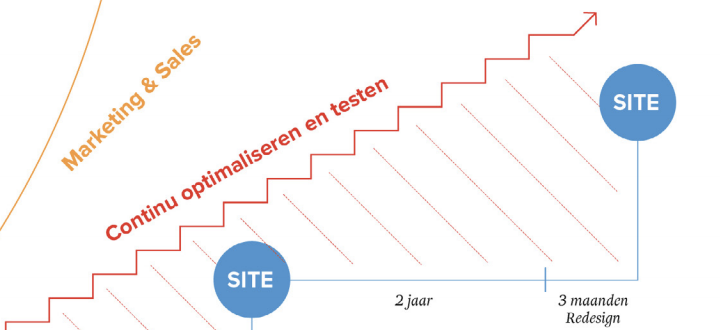Turn your website into a lead generator
In collaboration with Emerce - B2B companies are also making more work of online sales and bringing in leads. Seven steps to generate more and better leads through your website. Important: pull your sales team in especially during the design phase.
Websites used to be digital brochures, then they became a lead safety net. Now it is especially important for B2B companies to transform their website into a well-oiled sales machine. Within the sales process, your website is meant to make a human connection. With people working from home and having fewer face-to-face meetings, that connection is more important than ever.
Step 1: Build trust
Buyers are getting pickier about who they talk to. In consultative selling, buyer and seller invest a lot of time (and therefore money) in finding out the needs and finding a solution. Buyers want to be sure the time investment is going to be worth it. Of B2B buyers, 60% consider only one or two companies before contacting a potential seller. 75% of them only visit your website once. Therefore, you need to present your brand as accessible. Buyers want to do business with real people. This is all about solving problems and coming across as trustworthy. It should be immediately clear to buyers that you understand their problem and can solve it.
Step 2: Get the sales team involved
The key to success is getting the sales team on board with content design. They talk to leads and customers every day and know better than anyone what questions are asked the most. With that insight, you can determine what problems and solutions the content should be about. If you listen to recorded sales calls, you will naturally hear what qualifying questions the team asks.
During a sales call, customers ask the same questions they would type into a search engine. Therefore, make sure your SEM and SEO respond to these questions so that the sales qualification process is reproduced on your website.
Step 3: Provide lots of content
With gated content, you can bring in leads, but also provoke cynical responses. Data is commodity: buyers want assurance that your content is of use to them before they "pay" for access. Research shows that B2B buyers spend more time doing their own online research (27%) than meeting with potential suppliers (17%). So: the more useful content you have to offer, the more buyers will trust you and come back to you. An added benefit is that buyers qualify themselves and save your sales team work.
Step 4: Write good headlines
The hard truth is that your web copy is likely to be read more intently by competitors than by leads. Visitors typically scroll through the page at lightning speed and read only the headlines: that's all the time they have. If they stumble upon something relevant, they might slow down and scan the content. If scanning takes too much effort, they go back to the search results and click on another brand.Knock out all the copy except the headlines. Are you left with a good story then?
Step 5: Sell results, not features
Focus on selling results rather than features. Use case studies to demonstrate that you have a greater understanding of the customer's business challenges than just the pressing problem. For buyers, the customer journey usually begins with identifying their problem. When you emphasize results, you show that you can not only solve that specific problem, but also improve their business KPIs and make a broader impact. And a bigger impact means a bigger budget.
Step 6: Do your (analysis) homework
A solid measurement plan and reliable data model should be the foundation of every marketing and sales activity. Add a benchmark at every touchpoint in the user journey, but keep in mind that buyers rarely go through the buying process in a linear fashion.
Data comes from a variety of sources. In the ideal world, your data is available and accessible with minimal processing or delay on a single platform (such as the HubSpot CRM) with a KPI dashboard. This is already no easy task. Establish a test plan that allows you to measure the impact of each website change and track development on a timeline. Don't judge changes based solely on leads brought in. Look at the quality of your leads, conversion and return on investment as well.
Step 7: Keep the sales team involved
Your sales people are your company's barometer. If they feel heard and respected, you couldn't wish for a better source of feedback and ideas. Organizations where the Marketing and Sales departments set the course for website content have the best paperwork for a digital experience that supports the customer journey. Until recently, that was ruled out because of the complicated architecture and cumbersome Web design process. But now it's high time to put the sales team behind the wheel of your sales machine.

Want to get the most out of HubSpot? Subscribe to our newsletter, follow us on LinkedIn, or attend our HubSpot User Days!
Explore HubSpot User DaysShare this
You May Also Like
These Related Stories

Step-by-step guide to building a B2B website

From traditional to modern CMS: step out of the silo


